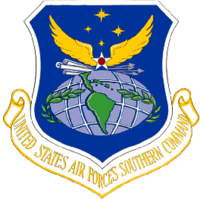United States Air Forces Southern Command: Difference between revisions
→Units Assigned: edited commands |
→History: added and expanded |
||
| Line 41: | Line 41: | ||
: Redesignated: '''United States Air Forces Southern Command''' July 8, 1963 |
: Redesignated: '''United States Air Forces Southern Command''' July 8, 1963 |
||
: Inactivated January 1, 1976 |
: Inactivated January 1, 1976 |
||
Note: Command was part of the '''Caribbean Defense Command''', (10 Feb 1941-1 Nov 1947), was the senior Army headquarters in the Canal Zone. The '''Caribbean Interceptor Command''', was the Air Force component (10 Feb 1941-17 Oct 1941) of the CIC until being inactivated and replaced by VI Interceptor Command. |
|||
===Units Assigned=== |
===Units Assigned=== |
||
Revision as of 22:25, 1 March 2009
| United States Air Forces Southern Command | |
|---|---|
 USAF Southern Command emblem | |
| Active | 1940–1976 |
| Country | United States of America |
| Branch | United States Air Force |
| Type | Major Command |
| Engagements |
|


United States Air Forces Southern Command (1963–1976) was a Major Command of the United States Air Force (USAF) responsible primarily for USAF activities in Central America, South America, and the Caribbean.
It was headquartered at Albrook Air Force Base, Canal Zone.
History
Lineage
Established as Panama Canal Air Force October 19, 1940
- Activated as a major command on November 20, 1940
- Redesignated: Caribbean Air Force. August 5, 1941
- Redesignated: 6th Air Force, September 18, 1942
- Redesignated: Caribbean Air Command, July 31, 1946
- Redesignated: United States Air Forces Southern Command July 8, 1963
- Inactivated January 1, 1976
Note: Command was part of the Caribbean Defense Command, (10 Feb 1941-1 Nov 1947), was the senior Army headquarters in the Canal Zone. The Caribbean Interceptor Command, was the Air Force component (10 Feb 1941-17 Oct 1941) of the CIC until being inactivated and replaced by VI Interceptor Command.
Units Assigned
- Commands
- VI Bomber Command, 25 Oct 1941-1 Nov 1946
- VI Interceptor Command, 17 Oct 1941
- Redesignated as: VI Fighter Command, May 1942-Oct 1943
- XXVI Fighter Command, 6 Mar 1942-25 Aug 1946
- XXXVI Fighter Command, 21 Aug 1942-30 Apr 1943
- VI Air Force Service Command, Undetermined
- Antilles Air Command, 11 Jul 1941-22 Jan 1949
- Wings
- 6 Fighter Wing, 25 Aug 1946-28 Jul 1948
- 13 Composite Wing, 1 Nov 1940-25 Oct 1941
- 19th Composite, 25 Jan 1933-26 Oct 1941
- 23d Fighter, 1949
- 24th Composite, 1967-1976
- 5700 Composite, 1948-1949; Air Base, 24 Oct 1954-8 Nov 1967
- Squadrons
- 4th Tactical Reconnaissance Squadron, 25 Aug 1946-1 Feb 1948
Assigned Stations
- Permanent
- Albrook Air Force Station, Canal Zone, 1932-1976
- France Air Force Base, Canal Zone, 1917-1949
- Howard Air Force Base, Canal Zone, 1939-1976
- Rio Hato Army Air Base, Panama, 1931-1948
- Borinquen (later Ramey) Air Force Base, Puerto Rico, 1936-1971
- (Assigned to Strategic Air Command, 26 May 1949)
- Wartime/Lend-Lease
Operational History
The first United States air units arrived in the Canal Zone in February 1917. By 1940, a rapid increase in the number of units warranted a new organization, and the Panama Canal Air Force was created as a major command.
In early 1942 the German Navy began anti-shipping operations using submarine in the Caribbean. The subs sank several tankers in the harbor at San Nicholas, Aruba and even shelled an oil refinery on the island. It's important to note that the refineries at the island of Aruba and Curacao possessed oil from wells in Venezuela and counted for one-third of the Allies supply of gasoline.
The first wartime mission of the newly created Sixth Air Force was to perform antisubmarine operations in the Caribbean Sea and the Gulf of Mexico areas and to cover Allied shipping convoys. Shortly after afterwards the 32nd got the assignment of fighting German submarines.
Sixth Air Force units had the responsibility for tracking down "Wolfpacks". The so-called "Wolfpacks", three of more subs together in a mission know as search and destroy. In the fall of 1942 the Germans reduced their submarine activity in the Caribbean region to concentrate its activity on the North Atlantic convoy route and the approaches to northwest Africa. With the withdrawal of submarines from the Caribbean region the Sixth Air Force concentrated its efforts as a striking force on its primary function of guarding against possible attacks on the Panama Canal. All of the wartime lend-lease bases were returned to civil authorities by 1950.
With the end of the war, the mission of Sixth Air Force and its successor units was changed to supporting friendly Central and South American air forces, and providing support to nations engaged in anti-communist activities during the Cold War.
When the command inactivated in 1976, most of its functions and resources passed to the Tactical Air Command, which established the USAF Southern Air Division (later 830th Air Division; Air Forces Panama) as the major organization in the area.
References
![]() This article incorporates public domain material from the Air Force Historical Research Agency
This article incorporates public domain material from the Air Force Historical Research Agency
- Maurer, Maurer (1983). Air Force Combat Units Of World War II. Maxwell AFB, Alabama: Office of Air Force History. ISBN 0892010924.
- [1] ArmyAirforces.Com
- [2] United States Air Forces Southern Command at US Air Force Historical Research Agency

